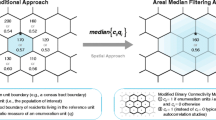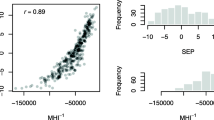Abstract
Area-level neighborhood socioeconomic status (NSES) is often measured without consideration of spatial autocorrelation and variation. In this paper, we compared a non-spatial NSES measure to a spatial NSES measure for counties in the USA using principal component analysis and geographically weighted principal component analysis (GWPCA), respectively. We assessed spatial variation in the loadings using a Monte Carlo randomization test. The results indicated that there was statistically significant variation (p = 0.004) in the loadings of the spatial index. The variability of the census variables explained by the spatial index ranged from 60 to 90%. We found that the first geographically weighted principal component explained the most variability in the census variables in counties in the Northeast and the West, and the least variability in counties in the Midwest. We also tested the two measures by assessing the associations with county-level diabetes prevalence using data from the CDC’s US Diabetes Surveillance System. While associations of the two NSES measures with diabetes did not differ for this application, the descriptive results suggest that it might be important to consider a spatial index over a global index when constructing national county measures of NSES. The spatial approach may be useful in identifying what factors drive the socioeconomic status of a county and how they vary across counties. Furthermore, we offer suggestions on how a GWPCA–based NSES index may be replicated for smaller geographic scopes.




Similar content being viewed by others
References
Braveman PA, Cubbin C, Egerter S, et al. Socioeconomic status in health research. JAMA. 2005;294(22):2879. https://doi.org/10.1001/jama.294.22.2879.
Diez-Roux AV, Merkin SS, Arnett D, et al. Neighborhood of residence and incidence of coronary heart disease. N Engl J Med. 2001;345(2):99–106. https://doi.org/10.1056/NEJM200107123450205.
Chaikiat Å, Li X, Bennet L, Sundquist K. Neighborhood deprivation and inequities in coronary heart disease among patients with diabetes mellitus: a multilevel study of 334,000 patients. Health place. 2012;18(4):877–82. https://doi.org/10.1016/j.healthplace.2012.03.003.
Major JM, Doubeni CA, Freedman ND, et al. Neighborhood socioeconomic deprivation and mortality: NIH-AARP diet and health study. Ross JS, ed. PLoS One. 2010;5(11):e15538. https://doi.org/10.1371/journal.pone.0015538.
Zierler S, Krieger N, Tang Y, et al. Economic deprivation and AIDS incidence in Massachusetts. Am J Public Health. 2000;90(7):1064–73. https://doi.org/10.2105/AJPH.90.7.1064.
Pickett KE. Multilevel analyses of neighbourhood socioeconomic context and health outcomes: a critical review. J Epidemiol Community Heal. 2001;55(2):111–22. https://doi.org/10.1136/jech.55.2.111.
James SA. Primordial prevention of cardiovascular disease among African-Americans: a social epidemiological perspective. Prev Med (Baltim). 1999;29(6):S84–9. https://doi.org/10.1006/pmed.1998.0453.
Haan M, Kaplan GA, Camacho T. Poverty and health prospective evidence from the Alameda County study. Am J Epidemiol. 1987;125(6):989–98. https://doi.org/10.1093/oxfordjournals.aje.a114637.
Hirsch AG, Carson AP, Lee NL, et al. The diabetes location, environmental attributes, and disparities network: protocol for nested case control and cohort studies, rationale, and baseline characteristics. JMIR Res Protoc. 2020;9(10):e21377. https://doi.org/10.2196/21377.
Messer LC, Laraia BA, Kaufman JS, et al. The development of a standardized neighborhood deprivation index. J Urban Heal. 2006;83(6):1041–62. https://doi.org/10.1007/s11524-006-9094-x.
Christine PJ, Auchincloss AH, Bertoni AG, et al. Longitudinal associations between neighborhood physical and social environments and incident type 2 diabetes mellitus. JAMA Intern Med. 2015;175(8):1311. https://doi.org/10.1001/jamainternmed.2015.2691.
** in middle-to-old aged US men and women. Sleep. 2018;41(7):zsy076. https://doi.org/10.1093/sleep/zsy076.
Lalloué B, Monnez J-M, Padilla C, et al. A statistical procedure to create a neighborhood socioeconomic index for health inequalities analysis. Int J Equity Health. 2013;12(1):21. https://doi.org/10.1186/1475-9276-12-21.
Bilal U, Hill-Briggs F, Sánchez-Perruca L, Del Cura-González I, Franco M. Association of neighbourhood socioeconomic status and diabetes burden using electronic health records in Madrid (Spain): the HeartHealthyHoods study. BMJ Open. 2018;8(9):e021143. https://doi.org/10.1136/bmjopen-2017-021143.
Demšar U, Harris P, Brunsdon C, Fotheringham AS, McLoone S. Principal component analysis on spatial data: an overview. Ann Assoc Am Geogr. 2013;103(1):106–28. https://doi.org/10.1080/00045608.2012.689236.
Centers for Disease Control and Prevention/Agency for Toxic Substances and Disease Registry/Geospatial Research, Analysis, and Services Program. CDC/ATSDR social vulnerability index database United States. https://www.atsdr.cdc.gov/placeandhealth/svi/.
University of Wisconsin School of Medicine and Public Health. Area deprivation index v2. https://www.neighborhoodatlas.medicine.wisc.edu/.
Mishra SV. Urban deprivation in a global south city-a neighborhood scale study of Kolkata. India Habitat Int. 2018;80:1–10. https://doi.org/10.1016/j.habitatint.2018.08.006.
Myint SW. An exploration of spatial dispersion, pattern, and association of socio-economic functional units in an urban system. Appl Geogr. 2008;28(3):168–88. https://doi.org/10.1016/j.apgeog.2008.02.005.
Jolliffe IT, Cadima J. Principal component analysis: a review and recent developments. Philos Trans R Soc A Math Phys Eng Sci. 2016;374(2065):20150202. https://doi.org/10.1098/rsta.2015.0202.
Pearson KLIII. On lines and planes of closest fit to systems of points in space. London, Edinburgh, Dublin Philos Mag J Sci. 1901;2(11):559–72. https://doi.org/10.1080/14786440109462720.
Hotelling H. Analysis of a complex of statistical variables into principal components. J Educ Psychol. 1933;24(6):417–41. https://doi.org/10.1037/h0071325.
Harris P, Brunsdon C, Charlton M. Geographically weighted principal components analysis. Int J Geogr Inf Sci. 2011;25(10):1717–36. https://doi.org/10.1080/13658816.2011.554838.
Stewart JE, Battersby SE, Lopez-De Fede A, Remington KC, Hardin JW, Mayfield-Smith K. Diabetes and the socioeconomic and built environment: geovisualization of disease prevalence and potential contextual associations using ring maps. Int J Health Geogr. 2011;10(1):18. https://doi.org/10.1186/1476-072X-10-18.
Andrews MR, Tamura K, Claudel SE, et al. Geospatial analysis of neighborhood deprivation index (NDI) for the United States by county. J Maps. 2020;16(1):101–12. https://doi.org/10.1080/17445647.2020.1750066.
Hong Y-R, Mainous AG. Development and validation of a county-level social determinants of health risk assessment tool for cardiovascular disease. Ann Fam Med. 2020;18(4):318–25. https://doi.org/10.1370/afm.2534.
Dunteman GH. Quantitative applications in the social sciences: principal components analysis. Newbury Park: SAGE Publications, Inc.; 1989. https://doi.org/10.4135/9781412985475.
Centers for Disease Control and Prevention. Diabetes Atlas. https://gis.cdc.gov/grasp/diabetes/DiabetesAtlas.html. Accessed 2 June 2020.
Haynes-Maslow L, Leone LA. Examining the relationship between the food environment and adult diabetes prevalence by county economic and racial composition: an ecological study. BMC Public Health. 2017;17(1):648. https://doi.org/10.1186/s12889-017-4658-0.
Deshpande AD, Baker EA, Lovegreen SL, Brownson RC. Environmental correlates of physical activity among individuals with diabetes in the rural Midwest. Diabetes Care. 2005;28(5):1012–8. https://doi.org/10.2337/diacare.28.5.1012.
Saydah SH, Imperatore G, Beckles GL. Socioeconomic status and mortality: contribution of health care access and psychological distress among U.S. adults with diagnosed diabetes. Diabetes care. 2013;36(1):49–55. https://doi.org/10.2337/dc11-1864.
O’Connor A, Wellenius G. Rural–urban disparities in the prevalence of diabetes and coronary heart disease. Public Health. 2012;126(10):813–20. https://doi.org/10.1016/j.puhe.2012.05.029.
Hirsch JA, Moore KA, Cahill J, et al. Business data categorization and refinement for application in longitudinal neighborhood health research: a methodology. J Urban Heal. 2021;98(2):271–84. https://doi.org/10.1007/s11524-020-00482-2.
Waldorf, B., Kim, A. The Index of Relative Rurality (IRR) : US County Data for 2000 and 2010. Purdue University Research Repository. 2018. https://www.doi.org/10.4231/R7959FS8.
Stacklies W, Redestig H, Scholz M, Walther D, Selbig J. pcaMethods – a bioconductor package providing PCA methods for incomplete data. Bioinformatics. 2007;23:1164–7.
Lu B, Harris P, Charlton M, Brunsdon C. The GWmodel R package: further topics for exploring spatial heterogeneity using geographically weighted models. Geo-spatial Inf Sci. 2014;17(2):85–101. https://doi.org/10.1080/10095020.2014.917453.
Harris P, Clarke A, Juggins S, Brunsdon C, Charlton M. Enhancements to a geographically weighted principal component analysis in the context of an application to an environmental data set. Geogr Anal. 2015;47(2):146–72. https://doi.org/10.1111/gean.12048.
Kind AJH, Buckingham WR. Making neighborhood-disadvantage metrics accessible — the neighborhood atlas. N Engl J Med. 2018;378(26):2456–8. https://doi.org/10.1056/NEJMp1802313.
Bilal U, Auchincloss AH, Diez-Roux AV. Neighborhood environments and diabetes risk and control. Curr Diab Rep. 2018;18(9):62. https://doi.org/10.1007/s11892-018-1032-2.
Kirby RS, Delmelle E, Eberth JM. Advances in spatial epidemiology and geographic information systems. Ann Epidemiol. 2017;27(1):1–9. https://doi.org/10.1016/j.annepidem.2016.12.001.
Saib M-S, Caudeville J, Beauchamp M, et al. Building spatial composite indicators to analyze environmental health inequalities on a regional scale. Environ Heal. 2015;14(1):68. https://doi.org/10.1186/s12940-015-0054-3.
Fernández S, Cotos-Yáñez T, Roca-Pardiñas J, Ordóñez C. Geographically weighted principal components analysis to assess diffuse pollution sources of soil heavy metal: application to rough mountain areas in Northwest Spain. Geoderma. 2018;311:120–9. https://doi.org/10.1016/j.geoderma.2016.10.012.
Logan JR, et al. Residential segregation by income, 1970–2009. Diversity and disparities: America enters a new century. New York: Russell Sage Foundation; 2014. pp. 208–31.
Hamad R, Brown DM, Basu S. The association of county-level socioeconomic factors with individual tobacco and alcohol use: a longitudinal study of U.S. adults. BMC Public Health. 2019;19(1):390. https://doi.org/10.1186/s12889-019-6700-x.
Funding
Centers for Disease Control and Prevention (R01DK124400).
Author information
Authors and Affiliations
Corresponding author
Additional information
Publisher’s Note
Springer Nature remains neutral with regard to jurisdictional claims in published maps and institutional affiliations.
Rights and permissions
About this article
Cite this article
De Silva, S.S.A., Meeker, M.A., Ryan, V. et al. Comparing Global and Spatial Composite Measures of Neighborhood Socioeconomic Status Across US Counties. J Urban Health 99, 457–468 (2022). https://doi.org/10.1007/s11524-022-00632-8
Accepted:
Published:
Issue Date:
DOI: https://doi.org/10.1007/s11524-022-00632-8




